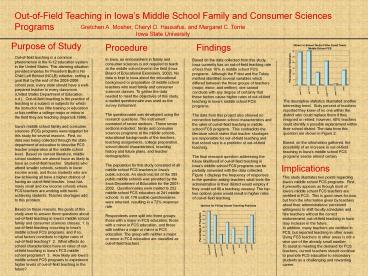Out-of-Field Teaching in Iowa - PowerPoint PPT Presentation
1 / 1
Title:
Out-of-Field Teaching in Iowa
Description:
Out-of-Field Teaching in Iowa s Middle School Family and Consumer Sciences Programs Gretchen A. Mosher, Cheryl O. Hausafus, and Margaret C. Torrie – PowerPoint PPT presentation
Number of Views:74
Avg rating:3.0/5.0
Title: Out-of-Field Teaching in Iowa
1
Out-of-Field Teaching in Iowas Middle School
Family and Consumer Sciences Programs
Gretchen A. Mosher, Cheryl O. Hausafus, and
Margaret C. Torrie Iowa State University
Purpose of Study
Procedure
Findings
Out-of-field teaching is a common phenomenon in
the K-12 education system in the United States.
This alarming situation provided impetus for
President Bushs No Child Left Behind (NCLB)
initiative, setting a goal that by the end of the
2005-2006 school year, every state should have a
well-prepared teacher in every classroom (United
States Department of Education, n.d.).
Out-of-field teaching is the practice of teaching
in a subject or subjects for which the instructor
has little training or education or has neither a
college major or minor in the field they are
teaching (Ingersoll,1999). Iowas middle school
family and consumer sciences (FCS) programs were
targeted for this study for several reasons.
First, no data was being collected through the
state department of education to describe FCS
teacher preparation at the middle school level.
Based on current literature, middle school
students are almost twice as likely to have an
out-of-field teacher. Students who attend
smaller schools, schools in lower income areas,
and those students who are low-achieving all have
a higher chance of having an out-of-field
teacher. Iowa has many small and low income
schools where FCS teachers are working with
lower-achieving students. Teacher shortages add
to this problem. Based on these reasons, the
goals of this study were to answer three
questions about out-of-field teaching in Iowas
middle school family and consumer sciences
classes. 1. Is out-of-field teaching occurring in
Iowas middle school FCS programs, and if so,
what factors contribute to higher rates of
out-of-field teaching? 2. What effects do
school characteristics have on rates of
out-of-field teaching in Iowas FCS middle school
programs? 3. How likely are Iowas middle
school FCS programs to experience higher levels
of out-of-field teaching in the future?
In Iowa, an endorsement in family and consumer
sciences is not required to teach at the middle
school level in the field (Iowa Board of
Educational Examiners, 2002). No data is kept in
Iowa about the educational background or
preparation of middle school teachers who lead
family and consumer sciences classes. To gather
the data needed to meet the objectives of this
study, a mailed questionnaire was used as the
survey instrument. The questionnaire was
developed using the research questions. The
instrument consisted of seven sections. These
seven sections included family and consumer
sciences programs at the middle schools,
educational backgrounds of the teachers, teaching
assignments, college preparation, school district
characteristics, teaching history and future
plans, and teacher demographics. The population
for this study consisted of all middle school FCS
teachers in Iowas public schools. An electronic
list of the 395 public middle schools was
provided by the Iowa Department of Education for
the 2001-2002. Questionnaires were mailed to 252
middle school FCS educators at 241 middle
schools. In all, 176 usable questionnaires were
returned, resulting in a 72 response
rate. Respondents were split into three groups
those with a major in FCS education, those with a
minor in FCS education, and those with neither a
major or minor in FCS education. The group with
neither a major or minor in FCS education are
classified as out-of-field teachers.
Based on the data collected from this study, Iowa
currently has an out-of-field teaching rate of
less than 10 in middle school FCS programs.
Although the F-test and the Tukey method
identified several variables which differed
between the three groups of teachers (major,
minor, and neither), one cannot conclude with any
degree of certainty that these factors cause
higher rates of out-of-field teaching in Iowas
middle school FCS programs. The data from this
project also showed no connection between school
characteristics and the rates of out-of-field
teaching in middle school FCS programs. This
contradicts the literature which states that
teacher shortages are responsible for
out-of-field teaching and that school size is a
predictor of out-of-field teaching. The final
research question addressing the future
likelihood of out-of-field teaching in Iowas
middle school FCS programs can be partially
answered with the data collected. Figure 1
displays the frequency of responses to the
question asking teachers what tools the
administration in their district would employ if
they could not fill a teaching vacancy. The top
two options given would result in higher rates of
out-of-field teaching.
The descriptive statistics illustrated another
interesting trend. Sixty percent of teachers
reported they knew of no one within the district
who could replace them if they resigned or
retired however, 40 teachers could identify a
possible replacement within their school
district. The data from this question are shown
in Figure 2. Based, on the information
gathered, the possibility of an increase in
out-of-field teaching in Iowas middle school FCS
programs seems almost certain.
Implications
This study illustrates two points regarding
Iowas middle school FCS programs. First, it
presently appears as though most of Iowas middle
school FCS teachers are certified in FCS. This
is good news for now, but from the information
given by teachers about their administrations
perceived willingness to shift faculty schedules
and hire teachers without the correct
endorsement, out-of-field teaching in Iowa may
increase in the future. In addition, many
teachers are certified in FCS, but reported
teaching in other areas. Using FCS teachers in
other areas is not a wise use of the already
small number. To assist in meeting the demand for
FCS teachers, current teachers should continue to
promote FCS education to secondary students as a
challenging and rewarding career.































